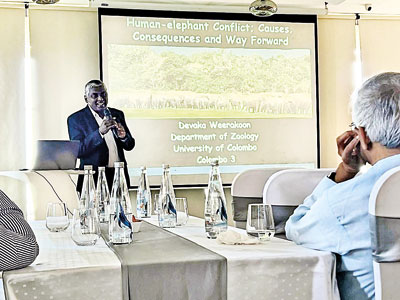Sunday Times 2
Human-elephant conflict: Abandon flawed decades-old strategy, embrace coexistence model, says expert
View(s):The present strategy pursued in managing wild elephants in Sri Lanka has many flaws, as it has failed to give due consideration to the growing body of research findings, reiterated a senior conservation biologist, showing the way forward without repeating the same failed measures.
Addressing the 46th annual general meeting (AGM) of the National Academy of Sciences of Sri Lanka (NASSL) recently on the ‘Human-Elephant Conflict (HEC): Causes, consequences and way forward’, Prof. Devaka K. Weerakoon of the Department of Zoology and Environment Sciences, University of Colombo, underscored that it is no surprise that in spite of heavy investment by the government, the HEC continues to escalate in Sri Lanka.
Therefore, Prof. Weerakoon, who holds many prestigious conservation posts, including being a member of the IUCN Asian Elephant Specialist Group, said the time has come to explore other management options, especially for elephants that range outside the Protected Areas (PAs), as they are the ones that cause conflict.

Prof. Devaka Weerakoon addressing the 46th annual general meeting (AGM) of the National Academy of Sciences of Sri Lanka
Sri Lanka supports around 6,000 wild elephants. Being a distinct sub-species which has the highest genetic diversity, this elephant population plays an important role in the overall conservation of Asian elephants.
Prof. Weerakoon pointed out that the present strategy for the management of wild elephants was conceived several decades ago based on a 1959 report. It recommended that elephants should be restricted to Protected Areas (PAs) managed by the Department of Wildlife Conservation (DWC) and a system of corridors established to link these PAs to facilitate the free movement of elephants.
This recommendation, he said, has been based on two beliefs—that the preferred habitat of elephants is undisturbed forest and elephants undertake long-range seasonal migrations. Six decades later, this strategy is still being pursued even though there is mounting scientific evidence proving it faulty.
“The DWC has persisted with several other management prescriptions for the past few decades, such as elephant drives; capture and translocation; electric fencing; establishing elephant corridors; providing deterrents to farmers; payment of compensation for death, injury or property damage; and habitat enrichment in PAs. However, all these prescriptions are based on the flawed age-old strategy,” he said.
On average, 70 people and 400 wild elephants die annually because of the HEC.
Here are excerpts of Prof. Weerakoon’s speech on the way forward:
A management option is to attract elephants ranging in human use areas into PAs. However, the scale of habitat management required to sustain this increased population within PAs makes it economically impossible. All PAs also cannot be converted to elephant habitats, as this would be detrimental to other species.
Alternatively, the elephants ranging in areas set aside for human use should be culled or captured for domestication. But this will seriously compromise their long-term survival potential, while culling is unacceptable in Sri Lanka for socio-cultural and political reasons.
Capture for domestication is also unacceptable given the environmental attitudes (as evidenced by the huge public outcry against the illegal capture of baby elephants in recent times) and the endangered status of the Asian elephants. This would also require domestication of several thousand elephants, which makes it an impractical alternative.
Therefore, the only remaining viable option is to allow elephants to access areas outside the PA network by efficiently managing the HEC. This would require a landscape-level approach to elephant management, based on scientific evidence gathered over the past two decades.
The wild elephant population can be grouped into three categories: elephants in PAs managed by the DWC; those in PAs managed by the Forest Department (FD); and those in human use areas.
The elephants that range in human-use areas comprising about 30% of the wild elephants are responsible for the HEC. Currently, PAs managed by the FD are largely excluded in elephant management, as evidenced by the construction of electric fences along the boundaries between some of them and those managed by the DWC, to prevent elephants from entering PAs managed by the FD. However, these fences are ineffective, as there are elephants on both sides, and they do not recognise administrative boundaries, only ecological boundaries. Therefore, PAs of both the DWC and FD in elephant ranging areas should be managed as a single entity.
The elephants that range in the human use areas, meanwhile, can be further classified into elephants that range in areas that are used temporarily by humans mainly for shifting cultivation and elephants that are in areas that are used permanently by humans for settlements or cultivation. The former can be used as Managed Elephant Reserves (MERs), where humans will use the area during the wet season for shifting cultivation that can be protected with temporary electric fences. These temporary fences can be taken down during the fallow season, allowing elephants to use these areas.
Long-term studies by the Centre for Conservation and Research show that such a coexistence model is possible in many areas, especially in the southern region of Sri Lanka.
The elephants ranging in permanent human use areas should be translocated to MERs or PAs, while conflict-causing elephants should be translocated to specially designed elephant holding areas.
A National Policy on Elephant Conservation and Management was drawn up outlining a new strategic approach to solve the HEC and approved by the Cabinet of Ministers in 2006. However, though nearly 10 years have elapsed, no steps have been taken by the DWC to translate it into a comprehensive action plan with a timeline for implementation.
Instead, the DWC is persisting with a failed management strategy, which amounts to repeating the same mistakes and expecting different results.

